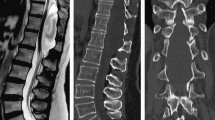Abstract
We present a case series of symptomatic post-operative spinal subdural extra-arachnoid collections that displace the cauda equina roots anteriorly. This is described as the “rising root sign”.








Similar content being viewed by others
References
Singleton WG, Ramnarine D, Patel N, Wigfield C. Post-operative spinal subdural extra-arachnoid hygroma causing cauda equina compression: a report of two cases. Br J Neurosurg. 2012;26(3):429.
Park J, Ahn R, Son D, Kang B, Yang D. Acute spinal subdural hematoma with hemiplegia after acupuncture: a case report and review of the literature. Spine J. 2013;13(10):e59.
Gakhar H, Bommireddy R, Klezl Z, Calthorpe D. Spinal subdural hematoma as a complication of spinal surgery: can it happen without dural tear? Eur Spine J. 2013;22(Suppl 3):S346.
Krishnan P, Banerjee TK. Classical imaging findings in spinal subdural hematoma—“Mercedes-Benz” and “cap” signs. Br J Neurosurg. 2015;9:1–2.
Sakka L, Gabrillargues J, Coll G. Anatomy of the spinal meninges. Neurosurgery. 2015; doi:10.1227/NEU.0000000000001048.
Adeeb N, Mortazavi MM, Tubbs RS. The cranial dura mater: a review of its history, embryology, and anatomy. Childs Nerv Syst. 2012;28(6):827–37.
Vandenabeele F, Creemers J, Lambrichts I. Ultrastructure of the human spinal arachnoid mater and dura mater. J Anat. 1996;189(Pt 2):417.
Kolias AG, Chari A, Santarius T, Hutchinson PJ. Chronic subdural haematoma: modern management and emerging therapies. Nat rev Neurol. 2014;10(10):570.
Reina MA, Prats-Galino A, Sola RG, et al. Structure of the arachnoid layer of the human spinal meninges: a barrier that regulates dural sac permeability. Rev Esp Anestesiol Reanim. 2010;57(8):486.
Fogel GR, Cunningham PY 3rd, Esses SI. Spinal epidural lipomatosis: case reports, literature review and meta-analysis. Spine J. 2005;5(2):202.
Braun P, Kazmi K, Nogues-Melendez P, Mas-Estelles F, Aparici-Robles F. MRI findings in spinal subdural and epidural hematomas. Eur J Radiol. 2007;64(1):119.
Author information
Authors and Affiliations
Corresponding author
Rights and permissions
About this article
Cite this article
Bharath, A., Uhiara, O., Botchu, R. et al. The rising root sign: the magnetic resonance appearances of post-operative spinal subdural extra-arachnoid collections. Skeletal Radiol 46, 1225–1231 (2017). https://doi.org/10.1007/s00256-017-2682-x
Received:
Revised:
Accepted:
Published:
Issue Date:
DOI: https://doi.org/10.1007/s00256-017-2682-x




